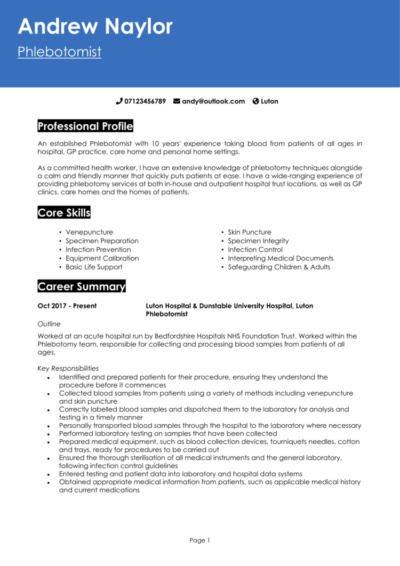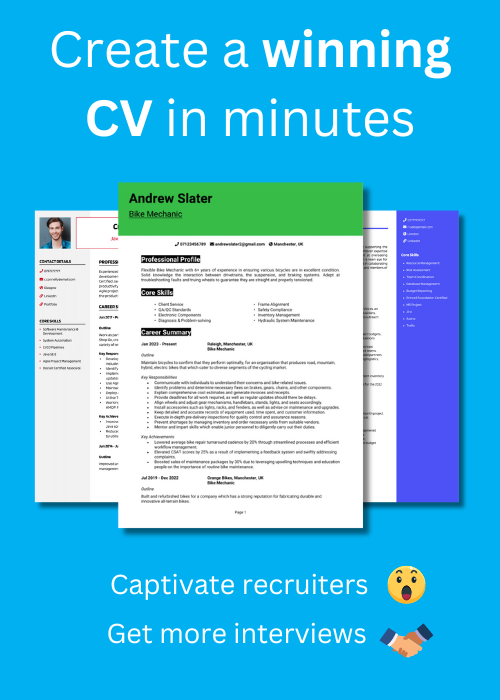Drawing blood is no problem, but drawing attention to your CV is another issue entirely.
Even with flawless technique, a poorly written CV can leave you out of the running. Recruiters don’t have time to process messy details, so your CV will need to read clearly and effortlessly.
This guide – with a Phlebotomist CV example – shows you how to put together a clear, professional CV that reflects your clinical skill and attention to hygiene and safety. It’s everything you need to secure more interviews and get hired faster.
Phlebotomist CV
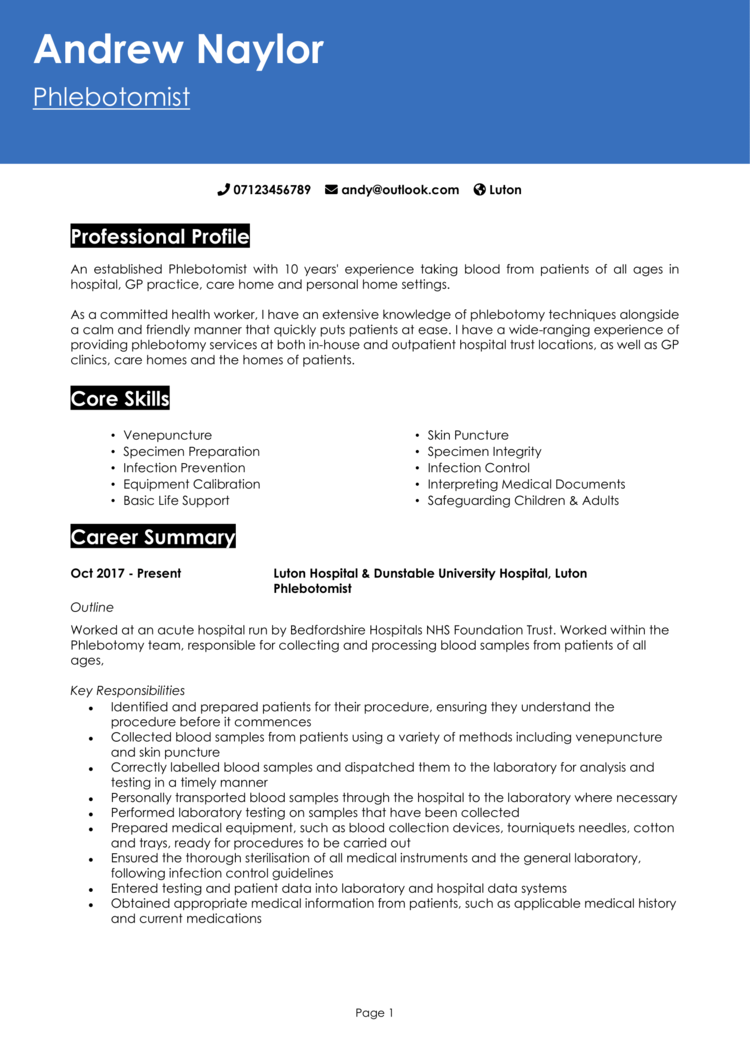
How to write your Phlebotomist CV
Discover how to craft a winning Phlebotomist CV that lands interviews with this simple step-by-step guide.
This guide will take you through writing a CV that works – from presenting your experience in clinical environments to highlighting your training, certifications, and soft skills.
This guide will show you how to write a CV that gives recruiters a clear impression of your capability and care.
Structuring and formatting your Phlebotomist CV
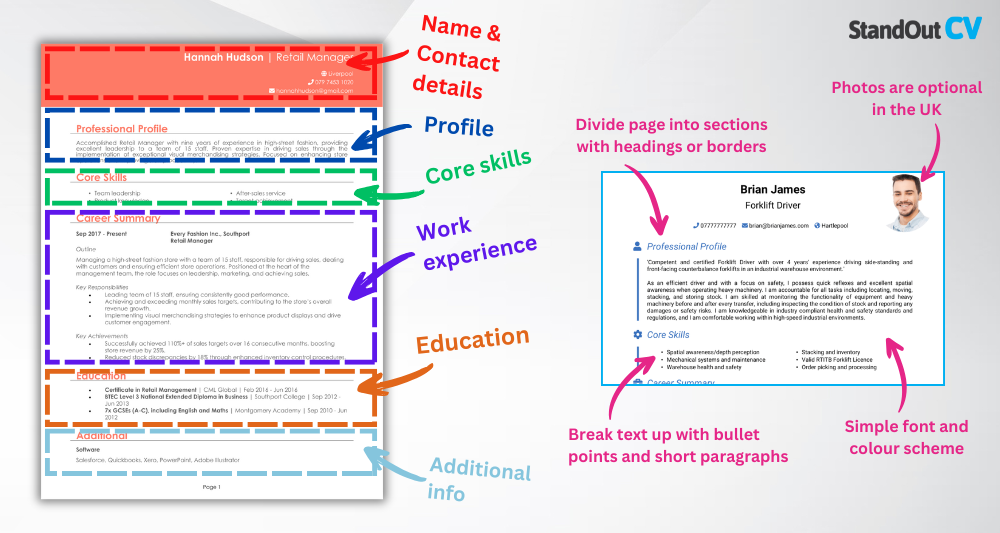
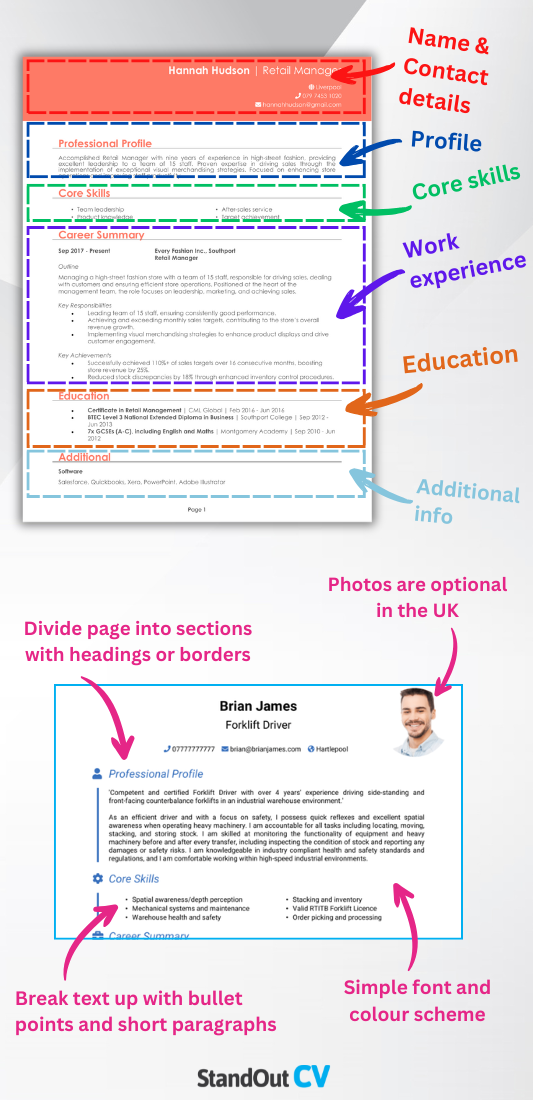
As a phlebotomist, structure and accuracy are non-negotiable – and your CV should reflect the same mindset. Think of it as your professional specimen label: everything needs to be clear, organised, and easy to process. Recruiters won’t have time to search through a cluttered layout or try to interpret vague job titles. A clean, well-structured CV makes it easy for them to see your qualifications, training, and clinical experience at a glance.
Here’s the layout to follow:
- Name and contact details – Place your name and personal details prominently at the top of your CV for quick access. Adding a photo is up to you.
- Profile – Open with a compelling overview of your skills, experience, and career goals.
- Core skills – List your key abilities in this section, focusing on those that will be most relevant to the job.
- Work experience – Provide a detailed breakdown of your work history, starting with the most recent job first.
- Education – List your qualifications, including degrees and relevant certifications, in reverse chronological order.
- Additional info – Use this optional space for relevant hobbies or personal pursuits that enhance your application.
To keep things sharp and reader-friendly, use clear section headings, break up large sections with bullet points where appropriate, and choose a tidy, professional font. Keep it to no more than two pages in length, and present everything as professionally as you would a patient interaction. Your CV format speaks volumes before they even read a word about your technique.
The best way to write a Phlebotomist CV profile


This opening paragraph is your chance to reassure the recruiter that you’re not only clinically competent but also calm, compassionate, and confident in your care.
It’s where you highlight the precision of your practice and your ability to balance technical skill with bedside manner. Whether you’re drawing samples in a packed ward or offering reassurance during a home visit, your CV profile should show that you’re not just good with needles – you’re good with people, too. This is your first impression, so make it count: convince recruiters that you’ll offer real value.
Phlebotomist CV profile examples
Profile 1
Experienced Phlebotomist with over eight years of experience in NHS hospital and GP surgery environments. Skilled in venepuncture, sample labelling, and working with a wide range of patients, including children and those with challenging veins. Committed to providing a calm, professional service with a focus on accuracy and patient comfort.
Profile 2
Reliable Phlebotomist with five years of clinical experience across private healthcare clinics and outpatient centres. Proficient in blood draw techniques, sample handling, and infection control protocols. Adept at managing high patient volumes while maintaining attention to detail and strong interpersonal care.
Profile 3
Dedicated Phlebotomist with six years of experience supporting community health services and pathology departments. Confident working independently in clinics, wards, and home visits. Known for a gentle, reassuring manner and consistently meeting turnaround times for laboratory submissions.
Details to put in your Phlebotomist CV profile
Make sure you include the following:
- Where you worked – Hospitals, clinics, community teams, labs, GP surgeries, blood donation centres
- Your top qualifications – Phlebotomy certification, clinical training, or NVQ in healthcare support
- Essential skills – Venepuncture, infection control, patient care, specimen handling
- Settings and patient groups – Adults, children, anxious patients, high-volume testing sites
- Strengths – Professionalism, patient reassurance, efficiency under pressure
How to present your core skills section properly


When a recruiter opens up any application, they’re automatically scanning for keywords. Use bullet points that show the balance of technical ability and patient-facing care that every good phlebotomist needs.
Tailor these CV skills to suit the role – especially if it involves paediatrics, mobile units, or high-volume hospital wards.
Key skills that make a Phlebotomist CV stand out
- Venepuncture and Blood Collection – Drawing blood from patients using correct venepuncture techniques for diagnostic or donation purposes.
- Patient Identification and Consent – Verifying patient details and obtaining informed consent prior to any procedure.
- Specimen Labelling and Handling – Ensuring accurate labelling, storage, and transport of blood samples to prevent contamination or misidentification.
- Infection Control and Hygiene Practice – Following strict protocols for hand hygiene, PPE use, and disposal of sharps and biohazard materials.
- Equipment Preparation and Maintenance – Setting up, using, and maintaining phlebotomy tools such as needles, vacutainers, and tourniquets.
- Pre- and Post-Procedure Care – Preparing patients for blood draws and ensuring their safety and comfort during and after collection.
- Data Entry and Record Management – Updating patient records, test requisitions, and sample logs accurately using electronic systems.
- Anatomy and Physiology Knowledge – Understanding circulatory system anatomy to select appropriate veins and minimise complications.
- Handling Difficult Draws – Managing challenging situations such as small veins, anxious patients, or multiple attempts with professionalism.
- Compliance with Legal and Ethical Standards – Adhering to confidentiality policies, consent regulations, and clinical governance procedures.
How to present your work experience in your CV


This section should reflect both your clinical ability and your reliability as part of a healthcare team. Whether you’ve worked in high-pressure wards or local surgeries, your experience should show you know how to deliver accurate and safe care.
Your work experience should focus on your responsibilities as well as your achievements. List your roles in reverse chronological order, starting with the most recent. Use bullet points under each role to break down the work you did – and where possible, link that to patient experience, safety, or outcomes.
How should you list jobs on your Phlebotomist CV?

- Outline – Summarise where you worked, what setting it was (e.g. hospital ward, outpatient clinic, mobile unit), and your general responsibilities as a phlebotomist.
- Responsibilities – List core duties using action words like “collected” and “processed.” For example: “collected blood samples from patients across multiple wards” or “processed and labelled specimens for immediate lab dispatch.” Mention procedures followed and any specialist tasks handled.
- Achievements – Show your value: did you manage high daily volumes? Receive patient praise? Improve sample turnaround? Use data where possible (e.g. “collected up to 40 samples per shift with zero errors”).
Work history examples for Phlebotomists
Phlebotomist | Briarhill NHS Trust
Outline
Provided phlebotomy services within a large general hospital, working across outpatient departments and inpatient wards to support routine and urgent diagnostic testing.
Responsibilities
- Collected blood samples via venepuncture following trust protocols and hygiene standards
- Labelled and transported specimens in line with laboratory requirements
- Supported clinicians by prioritising urgent samples and managing patient queues
- Used electronic health systems to confirm patient identity and update test orders
- Assisted in training new phlebotomists and healthcare assistants
Achievements
- Achieved 99.8% accuracy rate in sample labelling and documentation
- Received regular positive patient feedback for professional and friendly service
- Helped reduce morning blood draw delays by implementing improved rota planning
Phlebotomist | Parkside Diagnostics
Outline
Delivered phlebotomy services for a private healthcare provider specialising in wellness checks and corporate health screening across multiple London sites.
Responsibilities
- Performed venepuncture for full blood counts, hormone panels, and routine tests
- Maintained sterile environments and followed infection control protocols
- Handled patient queries and provided clear explanations of procedures
- Prepared samples for courier pickup and ensured correct batching and storage
- Recorded sample data into client CRM and laboratory systems
Achievements
- Reduced sample rejection rate by 20% through improved handling procedures
- Supported expansion of clinic capacity by covering three new screening sites
- Commended for calm and empathetic approach during high-pressure days
Phlebotomist | Grovefield GP Practice
Outline
Provided blood collection services at a busy GP surgery, supporting patient diagnostics and chronic condition monitoring for a patient population of over 8,000.
Responsibilities
- Performed blood draws for routine monitoring, INR checks, and urgent referrals
- Monitored stock levels of phlebotomy supplies and ordered replacements
- Provided support to elderly and anxious patients, including home visits when required
- Logged samples with local lab and resolved any returned or unclear results
- Worked closely with nurses and GPs to ensure timely follow-up of abnormal results
Achievements
- Increased daily blood draw capacity by 25% through improved appointment scheduling
- Received recognition from practice manager for consistently accurate lab documentation
- Reduced patient complaints around wait times by introducing clearer queue processes
Presenting your education history


This section highlights the training and academic background that underpins your ability to perform phlebotomy safely and effectively. Start with your most recent or relevant qualification – usually your phlebotomy certification or healthcare-related course – and work backwards.
Include any accredited training you’ve completed in phlebotomy procedures, as well as formal education such as healthcare diplomas or NVQs. If you’ve undertaken NHS-led or in-house training, it can also be listed here alongside academic qualifications.
You don’t need to go into detail unless you’re early in your career – but make sure each entry is clearly dated and titled. Keep everything concise and structured chronologically, with your most recent or advanced training listed first.
Best qualifications for a Phlebotomist
- Level 3 Certificate in Phlebotomy (e.g. OCN-accredited) – The most recognised practical training course for phlebotomists in the UK.
- Care Certificate (NHS or employer-led) – A baseline qualification for patient care and clinical safety.
- NVQ Level 2 or 3 in Health and Social Care – Useful for phlebotomists in wider healthcare assistant roles.
- In-House NHS Trust Phlebotomy Training – Accepted by many hospitals and often includes supervised practice.
- Infection Control and Venepuncture CPD Courses – Ongoing training that supports safety and clinical standards.


